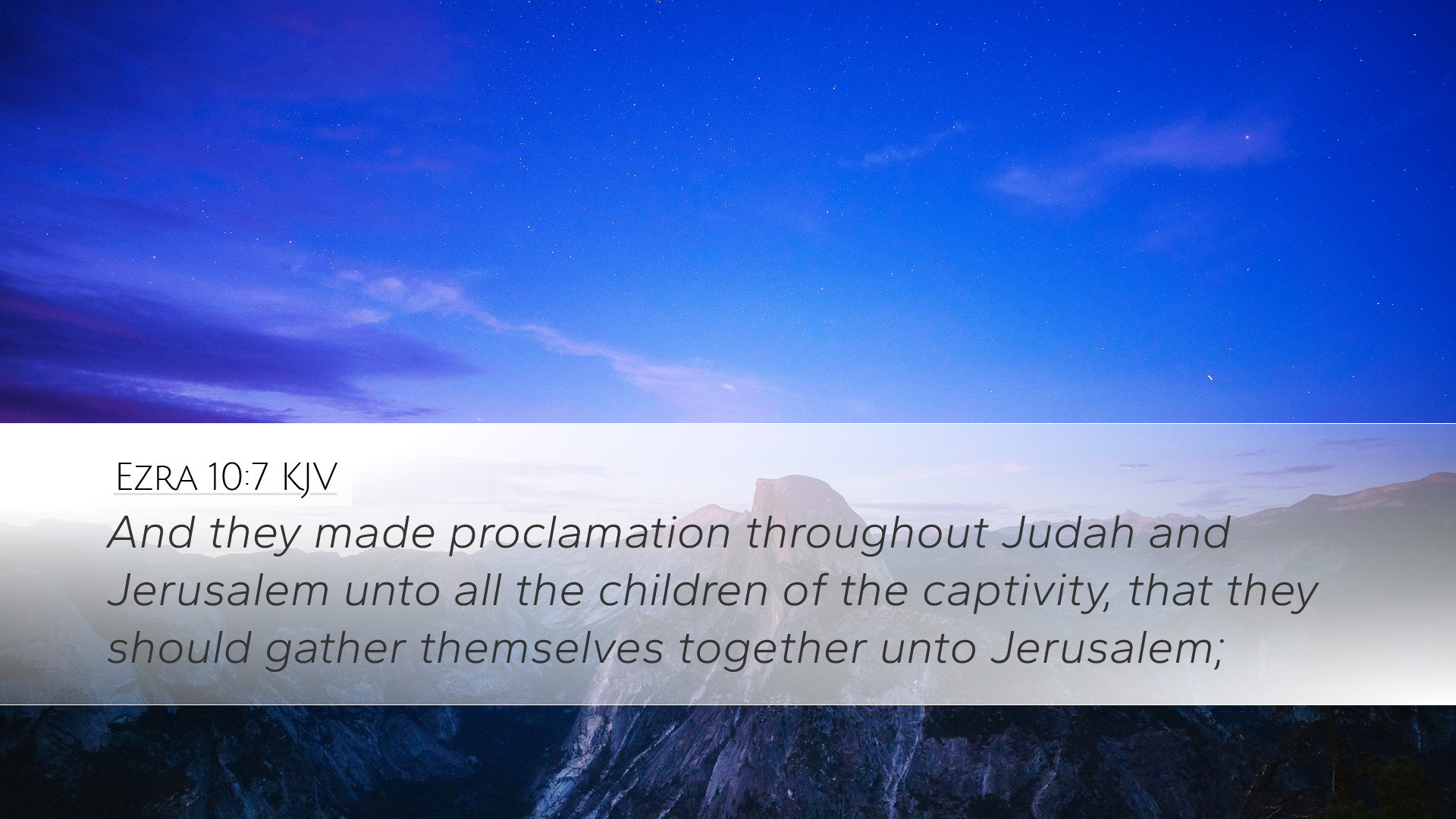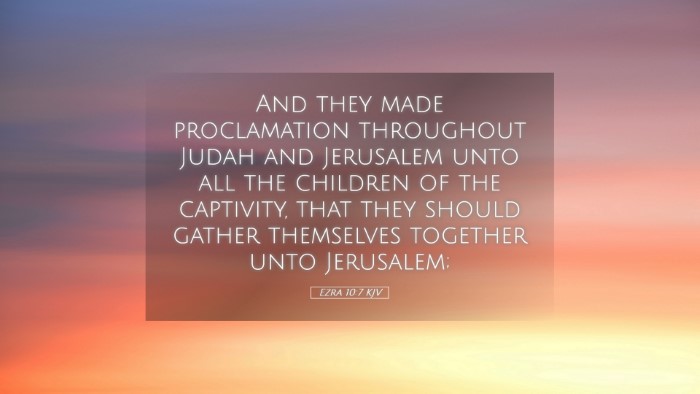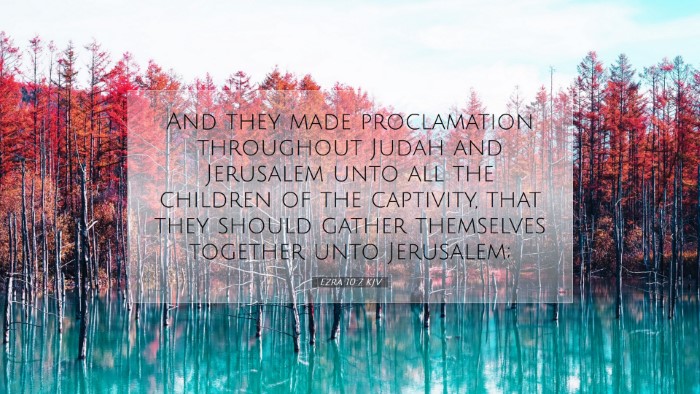Bible Commentary on Ezra 10:7
Ezra 10:7 states: "And they made proclamation throughout Judah and Jerusalem unto all the children of the captivity, that they should gather themselves together unto Jerusalem." This verse serves as a crucial moment in the narrative of Ezra, reflecting the urgency and importance of the message being conveyed to the exiled community. The proclamation called for a gathering in Jerusalem, aiming at addressing significant issues concerning the returning captives.
Contextual Background
To better understand Ezra 10:7, it is vital to explore the historical context of the Jewish exiles returning from Babylon. After decades in captivity, many Jewish people returned to their homeland under the leadership of Zerubbabel and Ezra. Their focus was on reinstating the worship of Yahweh and rebuilding the temple, which signified their national identity and covenant relationship with God.
The Importance of the Gathering
The call to gather was pivotal for several reasons:
- Collective Accountability: The gathering represented an opportunity for the people to collectively address their shared sins, particularly regarding intermarriage with foreign nations, which was against the Law of Moses.
- Leadership and Unity: Ezra, as a leader, sought to unify the community around a common cause—returning to God’s ordinances and re-establishing purity among the people.
- Spiritual Renewal: Beyond mere physical assembly, the gathering was a means for spiritual renewal, calling the people back to covenant faithfulness and the worship of Yahweh.
Analysis of the Proclamation
Ezra’s proclamation was a decisive step in implementing reform. This proclamation can be dissected as follows:
1. Announcement Across the Land
Ezra made the announcement throughout both Judah and Jerusalem. This method highlighted the significance of the issue at hand and aimed to reach all affected parties:
- Inclusivity: The message was to encompass all members of the community, from leaders to common people, emphasizing that sin and its consequences affected everyone.
- Urgency: The use of public proclamation underscores a sense of urgency in addressing the situation. The people needed to come together without delay to rectify their wrongs.
2. The Call for Gathering
Gathering "unto Jerusalem" was symbolically and physically significant:
- Homecoming: Jerusalem was not merely a location; it represented the heart of Jewish identity and worship. Returning to Jerusalem was a means of restoring their relationship with God.
- Symbol of Unity: Their gathering signaled a unified front where all would confront the issues of disobedience and seek restoration together.
Theological Implications
From a theological perspective, Ezra 10:7 illustrates several key principles:
1. The Nature of Repentance
The call to gather serves as an invitation to repentance. It reminds the people of their need for collective acknowledgment of sin and a return to the ways of the Lord:
- Corporate Confession: The act of gathering implies a process of corporate confession, recognizing that spiritual issues impact the entire community.
- Restorative Action: True repentance leads to actionable steps, emphasizing that genuine faith results in a transformed lifestyle.
2. Leadership’s Role in Spiritual Matters
Ezra’s role as a leader highlights the responsibility that spiritual leaders have in guiding their communities toward holiness:
- Proactive Leadership: Ezra took the initiative to lead the people, indicating the necessity of having leaders who actively address the community's spiritual needs.
- Encouraging Congregation: Good leaders encourage their congregations to pursue holiness and confront difficult issues head-on rather than remaining complacent.
Applications for Today
While the context of Ezra 10:7 is rooted in ancient history, its applications resonate profoundly today for pastors, educators, and scholars:
1. Taking Responsibility for Sin
Modern communities face similar challenges regarding collective sin. The need for a clear call to repentance and ethical living must be continuously emphasized:
- Community Engagement: Leaders today can learn from Ezra’s example by actively engaging their communities in discussions about spiritual and ethical concerns.
- Encouraging Transparency: Creating an environment where members can openly discuss decisions and lifestyles that may not align with scriptural teachings is essential.
2. The Call for Unity
Ezra's call to gather is also a timeless reminder of the importance of unity within the body of believers:
- Church as a Body: Emphasizing that the church functions as one body under Christ, every member plays a role in maintaining the health of the spiritual community.
- Collective Worship and Justice: The act of gathering signifies collective worship, prayer, and the pursuit of justice, urging the community to stand firm in their faith together.
Conclusion
Ezra 10:7 is a powerful verse that calls believers to reflect on their communal identity, the roles of leadership, and the necessity of coming together to confront sin and restore their covenant with God. Through the insights garnered from the public domain commentaries, it is evident that this text is not only historical but also profoundly relevant in the ongoing journey of faith and community life.


